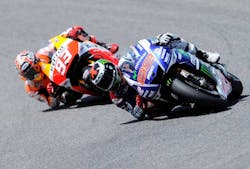Italian MotoGP debrief with Masao Azuma
The Italian Grand Prix was won by Movistar Yamaha MotoGP’s Jorge Lorenzo who secured a third successive MotoGP victory at Mugello ahead of Ducati Team’s Andrea Iannone and fellow factory Yamaha rider Valentino Rossi who finished in second and third place respectively.
Conditions were fine and sunny for the entire race weekend, with track temperatures reaching their maximum during the twenty-three lap race on Sunday, when a recording of 49°C was reached. During qualifying on Saturday, Iannone was able to set a new Mugello Circuit Best Lap record of 1’46.489, beating the old record by over half a second.
Q&A with Masao Azuma – Chief Engineer, Bridgestone Motorcycle tire Development Department
The Italian Grand Prix was the first race since Argentina when weather conditions were stable over the entire race weekend. Did this have an effect on the riders’ ability to get maximum performance from the tires?
“Yes we had reasonably stable conditions at Mugello, we saw at both Jerez and Le Mans that the track temperature on race day was considerably different to the previous days, which compromised some riders’ race setup. Throughout the whole weekend the pace was not only quick but extremely competitive and our revised tire allocation this year helped achieve this. Four out of the six slick compound options we brought to Mugello were used during the race, which indicates that there were enough options for the riders to comfortably negotiate this technically challenging circuit. It was good to set yet another qualifying lap record, however it seems the grip available on the circuit wasn’t good on Sunday as it was on Friday and Saturday as we narrowly missed out on setting a new race lap record as well.”
Some riders say that even if track temperatures are similar on race day, the grip level of the circuit during the race can be quite different to earlier on the weekend. Can you explain why this phenomenon occurs?
“There are a few factors as to why grip levels can change on race day, although it is difficult to understand all the reasons why. One of the reasons is perhaps down to the bikes themselves, as with a full fuel load and the riders pushing 100% in the early laps, the front end of the bike can be placed under huge loads which can result in understeer and other undesirable handling characteristics. Another factor could be that after the Moto3 and Moto2 race, there is a large amount of rubber laid on the tarmac on the racing line. This large amount of rubber on some types of tarmac can perhaps cause variable grip levels. When this does happen, it isn’t a major problem however, as most riders can adapt to the situation quite quickly. Also, our front tires are developed to provide good grip levels over a wide range of conditions, so the riders have enough control to manage this change in track behavior.”
The majority of riders selected the medium compound front slick for the race, but some riders were able to produce some impressive lap times using the hard compound front. What different advantages did these two compound options provide to the riders.
“Mugello has two distinct features that influence front tire choice. It features some extremely severe braking zones, particularly into turn one, and also several high speed corners and changes of direction. For the heavy braking zones, the extra stability of the hard compound front slick makes it an attractive option, and it also offers more consistent performance over race distance. For outright cornering performance, the medium compound has the advantage due to its slightly better edge grip. What ultimately decided which front tire each rider used on Sunday was how the particular strengths of that tire option complemented the riding style and machine setting of each individual. Both front tire options featured in the top five so either one was well suited to the demands of the Mugello circuit.”
